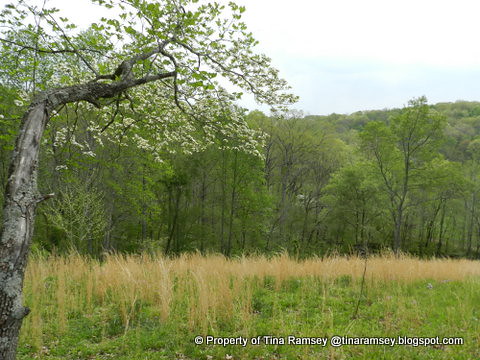
It has been more than one year since we purchased our land in Stewart County, so, with a new growing season I thought I'd update you all on the progress. First of all, progress in a garden is always an ongoing thing. Natural gardens and really all gardens change daily. This is so out at the land so these pictures are only a snapshot in time. They vary from vistas to wildflowers to cultivated flowers. The one thing they all have in common is that it is clear Mother Nature is in control because I simply cannot cultivate everything you see--nor do I wish too!
We start the tour with a beautiful vista down our back hill under a dogwood. This is a rather large hill and the vision is for it to be filled with wildflowers and grasses. This is where the majority of the wildflower seed was planted early this spring. An unexpected result of clearing this hill last spring has allowed a lot of already existing wildflowers to germinate and bloom. Some of them you will see in this post. On the day I took this shot Mr. Fix-it bushogged all of the broomsedge. This will allow even more sun to penetrate to the ground surface so that the wildflower seed that has germinated will get light and will grow.
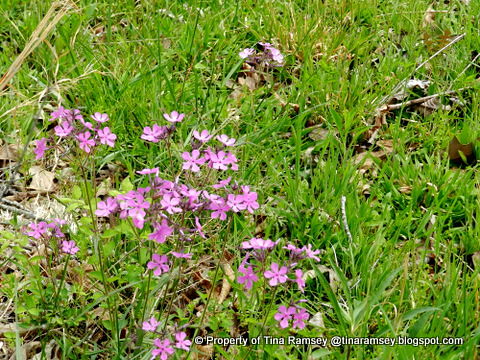
One of the surprises in the area that was mowed last fall was all of the phlox found growing on the Wildflower Hill. The pinks and purples are delightful.

This is a native wildflower that I actually transplanted to the little pond area by our overhead shelter. It is of course Solomon's Seal (Polygonatum species). This is one perennial I can't get enough of due to its long period of interest and ease of care. Also, thus far the deer have not eaten it! I have several different cultivars of it and also the False Solomon's seal (Smilicina racemosa now apparently changed to Maianthemum racemosum). I have been busy trying to move every bit of it out to the land and I am actually making progress. This clump was moved last year and came back wonderfully.
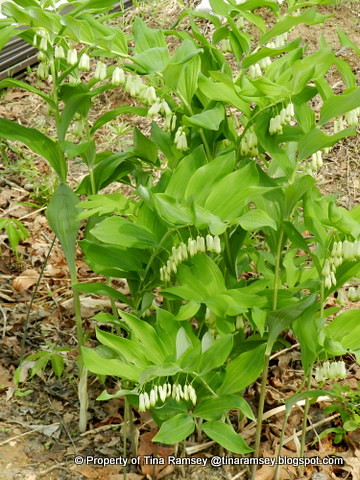
Another shot of the little clump by the little pond.
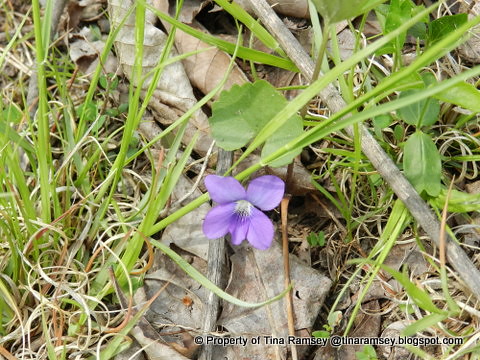
These violets were nice bits of color on the Wildflower Hill. I am not sure what type of violets they are so if anyone can positively identify them let me know please. It is probably a woodland violet.
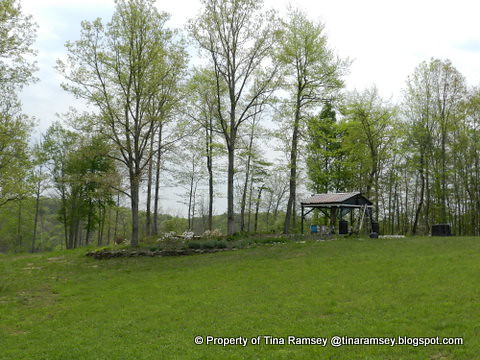
This is the view toward the overhead shelter I call the gazebo. If you will remember the canopy we had over the structure collapsed due to the weight of snow and ice within the last month or so. Mr. Fix-it did an outstanding job of replacing the roof with metal we had leftover from when our garage was built twelve years ago. Yes, I hold on to everything as you never know when you might need it. The metal is all different colors but it works to keep us dry and out of the sun. The gazebo is surrounded on the north and south by a prairie style garden. Behind the gazebo is a small pond and a woodland garden. This is also where the above Solomon's Seal grows. I'll post on the prairie garden later but for now suffice it to say it has growing in it: baptisias, asters, Tartarian asters, compass plant, helianthus, amsonia, salvias coneflowers, cannas, grasses, heucheras, catmint, sedum, veronica, liatris, and daylilies.
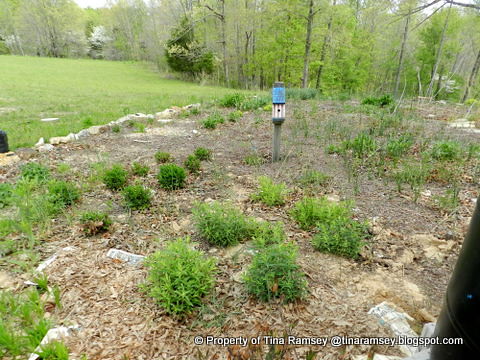
Here is an up close picture of the north side of the little gazebo. It looks like the plants are pretty far apart but remember these plants have been here only one year and will quickly fill in.The southern side has about 600 'Sun Disc' daffodils currently blooming in it but the whole area is pretty much natural. The electrical transformers and wiring is scheduled to go in the area so I have not done much with that side.

This is the view on the extreme north side of the prairie garden under the oaks. Here the divider between a cultivated area and the wild area are stepping stones. These heucheras 'Miracle' you see as the chartreuse foliage in the foreground are a truly a miracle. I planted them last spring and never watered them. They kept their foliage all winter long. As this new foliage came in the deer kindly came and ate all of the old foliage. I don't know how that happened but it did. I hope they leave the new foliage alone. These heucheras are a tough, large, and vigorous cultivar of heuchera. I highly recommend it. Also, these can take a lot of direct sun because they get the western sun each afternoon.
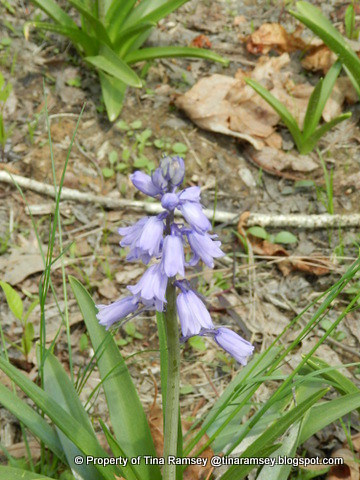
Spanish bluebells grow along side some pink Spanish bluebells behind the gazebo by the pond. They were moved while in bloom last spring and barely winked at the move. Firepinks have also joined the chorus in this area and the red of their flowers contrasts nicely with the blue and pinks of the Spanish bluebells.
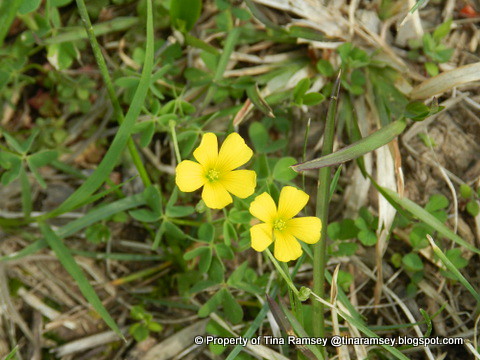
I am not sure what this little yellow wildflower could be. It is growing sporadically in the field. It is a pretty yellow.
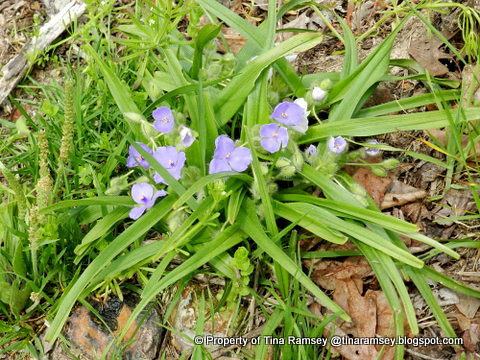
I had transplanted a lot of spiderworts out to the Driveway Garden. Imagine how surprised I was to find spiderworts growing wild on our Wildflower Hill. This type may be Tradescantia subaspera. It prefers moist, acidic soil and that is exactly what we have--even on the hill during certain periods of the year, like spring. This pretty little clump was mowed over by me while I cut the grass, but it seems to have not suffered any major damage. Big sigh of relief.

'Florida Flame' azaleas are blooming. I am loving the azaleas this year and so far the deer have not nibbled on them, tho they have sampled the rhododendrons. I can completely forget about hollies as they are all chewed down to nubs. Darn deer.

This last picture is of another wildflower area in our back corner of the field. The columbo grows here with wild abandon. Many of these American columbos are getting ready to bloom. I love this area as the columbo looks like hostas coming and so prolific are they that the sight is really something. Within another month or so all of these columbo will have gone completely dormant and the summer wildflowers such as butterfly weed, lespedeza, goldenrod, and asters will take over. Also growing on the land but no pictures of them are: ragweed (transplanted and wild), yellow rocket, waterleaf, and many, many more wildflowers yet to be identified....
in the garden....
We are finally breaking ground on the house so I am very busy working on that, but gardening is never far from my heart. I think that hopefully by the time the house is done most of my gardens will be moved. I've worked more than one year on this process but it is a very time consuming thing and I am not really where I need to be. As it is, it looks like I'll have another winter season to get everything moved before we put our house on the market. This is great news for me because as wonderful as it is having a new house to be, it is ever more so wonderful to have a new garden I create from scratch. I am so excited to have this opportunity! Thanks for following along....in the garden.




 Tina says this one is called "Mocha Mint
Tina says this one is called "Mocha Mint














 Mocha Mint
Mocha Mint










